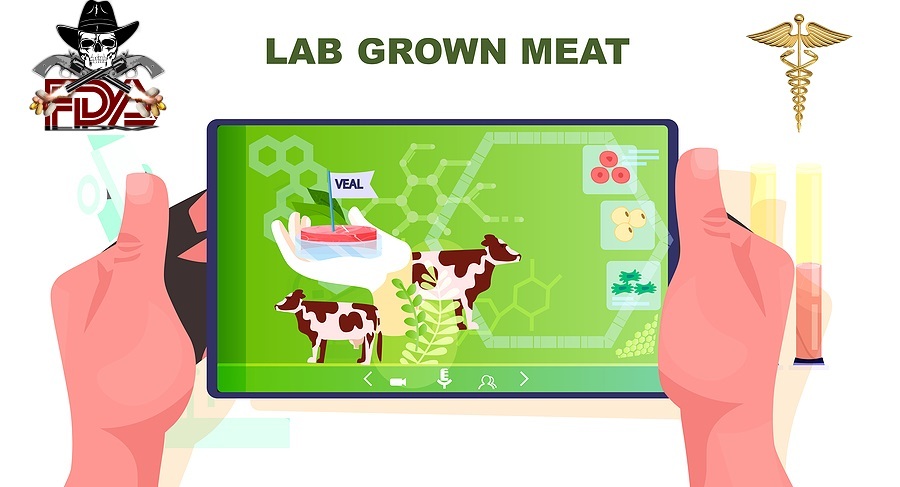by Brian Shilhavy, Health Impact News:

Researchers at the University of California, Davis, have just published a study that looked at the environmental impacts of lab-cultured meat, and they have determined that based on current production methods, the global warming potential (GWP) of lab-cultured beef would be approximately 25% greater than conventional beef cows raised on farms.
The study also concluded that the “fossil fuel depletion” of lab-cultured beef is “approximately 3 to 17 times greater” than producing boneless beef.
TRUTH LIVES on at https://sgtreport.tv/
This contradicts the reasoning behind those rushing to bring a lab-cultured meat product to market, who are claiming that massive production of lab-grown meat would have a more positive impact on the environment than raising beef cattle.
There are currently no lab-cultured meats on the market, because the production costs are still too expensive to scale it for public consumption, and this appears to be the first study conducted to look at the environmental impacts of mass-producing red meat in a laboratory.
One of the major problems so far with culturing meat in a laboratory, is that the growth mediums used to culture the meat produce endotoxins, which means pharmaceutical products are needed to reduce these endotoxins and purify the lab-grown meat.
This has led one of the researchers at UC Davis to ask what exactly is being produced in the lab with these “cultured meats”:
Is it a pharmaceutical product or a food product?
From the study:
One aspect of this refinement is the endotoxin reduction/removal for each growth medium component.
Endotoxins, also known as lipopolysaccharides (LPS) are a critical component of the outer membrane of Gram-negative bacteria. Endotoxins contain a hydrophilic polysaccharide fraction, which is covalently bonded to a hydrophobic lipid known as lipid A (Magalhães et al., 2007).
Gram negative bacteria are ubiquitous to the environment and are commonly found in tap water (Vaz-Moreira et al., 2017).
In cell culture the presence of endotoxin can have a wide variety of effects.
For example, at an endotoxin concentration as low as 1 ng/ml it reduced pregnancy success rates by 3 to 4-fold during in vitro fertilization of human IVF embryos (Dawson, 1998; Fishel et al., 1988; Snyman & van der Merwe, 1986).
Gram negative bacteria shed small amounts of endotoxin into the environment when they proliferate and shed large amounts when they are inactivated (Corning, 2020).
Current mediums used to culture meat in the laboratory also utilize serum from the blood of fetal calves, which would mean that these lab-cultured meats could not be certified “kosher” or “halal” for Jews and Muslims, which require all the blood from the animal to be drained at the time of slaughter.
Animal cell growth mediums have historically utilized fetal bovine serum (FBS) which contains a variety of hormones and growth factors (Jochems et al., 2002).
Serum is blood with the cells, platelets and clotting factors removed. Processing of FBS to be utilized for animal cell culture is an 18-step process that is resource intensive due to the level of refinement required for animal cell culture. (Full study.)
Let’s hope and pray that these lab-cultured meats never make it to market due to cost issues preventing them from scaling production for the mass market.
Because if they do start mass-producing this, you can be sure the Government will subsidize it and start putting it into institutional food at publicly-funded facilities such as schools, hospitals, prisons, FEMA camps, etc.
We already know that the corrupt FDA is a branch of the pharmaceutical industry, and that they have no problem authorizing or approving dangerous products that maim and kill people reducing the population.

We also know that beef production does not have to be harmful to the environment if they are raised on pasture rather than in confined feeding lots for mass production. Grass-fed beef operations are actually positive for the environment. See:
I’ve been working with small-scale mostly family farmers for over 2 decades now, offering the public REAL food from grass-fed animals.
If the public were to change their values and eating habits to support local producers like this, it would transform the food industry and create many jobs.
But Americans spend the least amount of their income on food than any other nation in the world, and prefer cheap, contaminated, commodity food that is subsidized by the government, instead of locally-produced ethical food that is more labor intensive, and also costs more because it is not subsidized by the Government.
Read More @ HealthImpactNews.com



